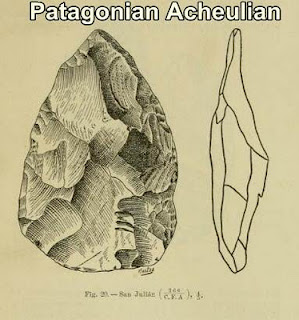Acheulean Tools in Patagonia. From [1] Outes
In the early 1900s, Patagonia was still an unknown place, which held (it still does, one century later!) many unsolved mysteries. Furthermore, conflicting theories about the origin of human beings were confronted and one of their battle grounds was Patagonia.
Florentino Ameghino and Francisco Moreno, though implacable enemies, defended an American origin of mankind. Papers written at that time in Argentina, supported this idea.
It is refreshing to find one that dares to voice an opposing point of view, one written by Felix Outes.[1] (who published it in Ameghino's Museum's magazine), in which he analyses Patagonia's "stone age"
No ancient dolichocephalics!
He believed that the people of Patagonia were not autocthonous, yet he cautiously added:
“I believe that in those territories there has been a substratum, which has certainly been well defined, of a paleolithic type, whose osteological [bones] remains are still unknown to us, but whose primitive industry I will describe [later]” [1].
So it seems that he thought that Patagonia held, concealed in its vast empty spaces, the remains of ancient humans who were the authors of the Acheulean tools he found there. By the way, one of these stone tools is shown above, and was found in Santa Cruz province, at San Julián, and is 155 mm high, 102 mm wide and 31 mm thick (6.1 x 4.0 x 1.22 in.).
Acheulean tools are a very primitive variety of stone instruments which were the work of our more distant relatives, Neanderthals, Homo erectus, H. ergaster, etc. They were later replaced by more advanced lithic industries. Though, archaic modern humans did use later, more advanced kinds of Acheulean tools.
The interesting thing, from my point of view is that the Patagonian Acheulean tools do point at some “archaic” humans or Neanderthals in the region.
Outes then goes on to state that (Moreno’s) dolichocephalic people and the modern natives with brachicephalic skulls, were contemporary, the former never entered the heart of Patagonia beyond 41° S, and stopped on the shores of the Negro River, while the latter reached the Strait of Magellan and Tierra del Fuego.
He also says that “I believe that it is a mistake to consider as exaggeratedly ancient those dolichocephalic skulls that have been found until now. The long skulled peoples, I have reasons to believe this, still existed in large numbers at the historical time of the Spanish Conquest, not only on the Negro River, but also in the south of the province of Buenos Aires, and even in Entre Ríos province...”
And once again stated that the “Quaternary Patagonian man has not yet been discovered (rebuffing Moreno's "ancient" Patagons with dolichocephalic crania). 106 years later they still haven't been found (or, I would say, they haven't even been "looked for" by Argentina's poorly funded scientists).
Outes closed his article concluding that the “Patagonian Paleolithic industry compared to the European, has a great similarity in shapes, etc., with the one that defines the Acheulean period according to Mr. G.de Mortillet’s classification and corresponds to the Chelleo-Mousterian transition period ...”
He then added that this lithic technology is found in Patagonia in “undoubtedly more modern geologic formations than those in which their European counterparts are found” believing that this is due to the backwardness of the human groups that inhabited the southern tip of America.
A Typical mindset of those bigoted -not to say racist- days (classing people as primitive or advanced).
An intriguing thought... Could the relatively modern sites with Acheulean tools be due to a contemporary survival of ancient human groups in Patagonia? That is, they did not reflect "primitive" modern humans but Neanderthals with their traditional Acheulean technology?
Source
[1] Oütes, Félix F., (1905). La edad de la piedra en Patagonia. Estudio de arqueología comparada. Anales del Museo Nacional de Buenos Aires. Serie III. Tomo V. Buenos Aires, A. Alsina Impr. Aug. 10, 1905. Pp. 203.
Patagonian Monsters - Cryptozoology, Myths & legends in Patagonia2011 International Year of Forests Copyright 2009-2011 by Austin Whittall ©


















No comments:
Post a Comment